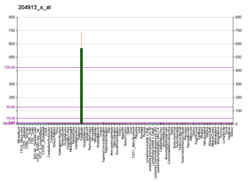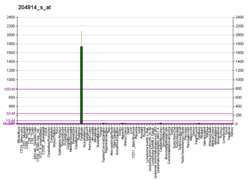SOX11
Transcription factor SOX-11 is a protein that in humans is encoded by the SOX11 gene.[5][6][7]
Function
[edit]This intronless gene encodes a member of the group C SOX (SRY-related HMG-box) transcription factor family involved in the regulation of embryonic development and in the determination of the cell fate. The encoded protein may act as a transcriptional regulator after forming a protein complex with other proteins. The protein may function in the developing nervous system and play a role in tumorigenesis and adult neurogenesis.[7][8] Tuj1 and Tead2 are suggested as direct target of Sox11.[9][10][11]
Clinical aspect
[edit]Lymphocyte staining for SOX11 immunohistochemistry indicates mantle cell lymphoma (cyclin D1 positive and negative) rather than other mature lymphoid neoplasms or normal lymphocytes.[12]
Mutations in SOX11 are associated with Coffin–Siris syndrome[13] and mantle cell lymphoma.[14]
See also
[edit]References
[edit]- ^ a b c GRCh38: Ensembl release 89: ENSG00000176887 – Ensembl, May 2017
- ^ a b c GRCm38: Ensembl release 89: ENSMUSG00000063632 – Ensembl, May 2017
- ^ "Human PubMed Reference:". National Center for Biotechnology Information, U.S. National Library of Medicine.
- ^ "Mouse PubMed Reference:". National Center for Biotechnology Information, U.S. National Library of Medicine.
- ^ Jay P, Gozé C, Marsollier C, Taviaux S, Hardelin JP, Koopman P, Berta P (Sep 1995). "The human SOX11 gene: cloning, chromosomal assignment and tissue expression". Genomics. 29 (2): 541–5. doi:10.1006/geno.1995.9970. PMID 8666406.
- ^ Wiebe MS, Nowling TK, Rizzino A (May 2003). "Identification of novel domains within Sox-2 and Sox-11 involved in autoinhibition of DNA binding and partnership specificity". The Journal of Biological Chemistry. 278 (20): 17901–11. doi:10.1074/jbc.M212211200. PMID 12637543.
- ^ a b "Entrez Gene: SOX11 SRY (sex determining region Y)-box 11".
- ^ Haslinger A, Schwarz TJ, Covic M, Lie DC (Jun 2009). "Expression of Sox11 in adult neurogenic niches suggests a stage-specific role in adult neurogenesis". The European Journal of Neuroscience. 29 (11): 2103–14. doi:10.1111/j.1460-9568.2009.06768.x. PMID 19490090. S2CID 42742018.
- ^ Bergsland M, Werme M, Malewicz M, Perlmann T, Muhr J (Dec 2006). "The establishment of neuronal properties is controlled by Sox4 and Sox11". Genes & Development. 20 (24): 3475–86. doi:10.1101/gad.403406. PMC 1698453. PMID 17182872.
- ^ Bhattaram P, Penzo-Méndez A, Sock E, Colmenares C, Kaneko KJ, Vassilev A, Depamphilis ML, Wegner M, Lefebvre V (Apr 2010). "Organogenesis relies on SoxC transcription factors for the survival of neural and mesenchymal progenitors". Nature Communications. 1 (1): 9. Bibcode:2010NatCo...1....9B. doi:10.1038/ncomms1008. PMC 2892298. PMID 20596238.
- ^ Larson BL, Ylostalo J, Lee RH, Gregory C, Prockop DJ (Nov 2010). "Sox11 is expressed in early progenitor human multipotent stromal cells and decreases with extensive expansion of the cells". Tissue Engineering. Part A. 16 (11): 3385–94. doi:10.1089/ten.tea.2010.0085. PMC 2965191. PMID 20626275.
- ^ Anna Dusenbery, M.D., Mark R. Wick, M.D. "Stains & CD markers - SOX11". Pathology Outlines.
{{cite web}}: CS1 maint: multiple names: authors list (link) Topic Completed: 1 January 2018. Minor changes: 12 August 2021 - ^ Tsurusaki Y, Koshimizu E, Ohashi H, Phadke S, Kou I, Shiina M, Suzuki T, Okamoto N, Imamura S, Yamashita M, Watanabe S, Yoshiura K, Kodera H, Miyatake S, Nakashima M, Saitsu H, Ogata K, Ikegawa S, Miyake N, Matsumoto N (2014). "De novo SOX11 mutations cause Coffin-Siris syndrome". Nature Communications. 5: 4011. Bibcode:2014NatCo...5.4011T. doi:10.1038/ncomms5011. PMID 24886874.
- ^ Vose, Julie M. (August 2017). "Mantle cell lymphoma: 2017 update on diagnosis, risk-stratification, and clinical management". American Journal of Hematology. 92 (8): 806–813. doi:10.1002/ajh.24797. ISSN 1096-8652. PMID 28699667.
Further reading
[edit]- Wilson M, Koopman P (Aug 2002). "Matching SOX: partner proteins and co-factors of the SOX family of transcriptional regulators". Current Opinion in Genetics & Development. 12 (4): 441–6. doi:10.1016/S0959-437X(02)00323-4. PMID 12100890.
- Schepers GE, Teasdale RD, Koopman P (Aug 2002). "Twenty pairs of sox: extent, homology, and nomenclature of the mouse and human sox transcription factor gene families". Developmental Cell. 3 (2): 167–70. doi:10.1016/S1534-5807(02)00223-X. PMID 12194848.
- Gozé C, Poulat F, Berta P (Jun 1993). "Partial cloning of SOX-11 and SOX-12, two new human SOX genes". Nucleic Acids Research. 21 (12): 2943. doi:10.1093/nar/21.12.2943. PMC 309692. PMID 8332506.
- Kuhlbrodt K, Herbarth B, Sock E, Enderich J, Hermans-Borgmeyer I, Wegner M (Jun 1998). "Cooperative function of POU proteins and SOX proteins in glial cells". The Journal of Biological Chemistry. 273 (26): 16050–7. doi:10.1074/jbc.273.26.16050. PMID 9632656.
- Azuma T, Ao S, Saito Y, Yano K, Seki N, Wakao H, Masuho Y, Muramatsu M (Oct 1999). "Human SOX11, an upregulated gene during the neural differentiation, has a long 3' untranslated region". DNA Research. 6 (5): 357–60. doi:10.1093/dnares/6.5.357. PMID 10574465.
- Lee CJ, Appleby VJ, Orme AT, Chan WI, Scotting PJ (May 2002). "Differential expression of SOX4 and SOX11 in medulloblastoma". Journal of Neuro-Oncology. 57 (3): 201–14. doi:10.1023/A:1015773818302. PMID 12125983. S2CID 20719302.
- Ballif BA, Villén J, Beausoleil SA, Schwartz D, Gygi SP (Nov 2004). "Phosphoproteomic analysis of the developing mouse brain". Molecular & Cellular Proteomics. 3 (11): 1093–101. doi:10.1074/mcp.M400085-MCP200. PMID 15345747.
- Bouma GJ, Albrecht KH, Washburn LL, Recknagel AK, Churchill GA, Eicher EM (Jul 2005). "Gonadal sex reversal in mutant Dax1 XY mice: a failure to upregulate Sox9 in pre-Sertoli cells". Development. 132 (13): 3045–54. doi:10.1242/dev.01890. PMID 15944188.
- Thevenet L, Albrecht KH, Malki S, Berta P, Boizet-Bonhoure B, Poulat F (Nov 2005). "NHERF2/SIP-1 interacts with mouse SRY via a different mechanism than human SRY". The Journal of Biological Chemistry. 280 (46): 38625–30. doi:10.1074/jbc.M504127200. PMID 16166090.
- DesGroseilliers M, Fortin F, Lemyre E, Lemieux N (2006). "Complex mosaicism in sex reversed SRY+ male twins". Cytogenetic and Genome Research. 112 (1–2): 176–9. doi:10.1159/000087532. PMID 16276109. S2CID 43826181.
External links
[edit]- Overview of all the structural information available in the PDB for UniProt: P35716 (Human Transcription factor SOX-11) at the PDBe-KB.







